Karen Commins's Blog, page 6
April 4, 2018
6 Low-Cost Avenues For Greater Audiobook Sales

Congratulations! You’ve got a brand new audiobook! It’s time to get the word out about it!
I minored in marketing while in college and have always loved to think about marketing ideas. Sandra Beckwith at BuildBookBuzz.com recently asked me a number of questions related to audiobook marketing. Our interview was posted today, and you can read it here.
A while back, I wrote 2 articles on the ACX.com blog to address this very topic. In Part One, I explained some reasons why people are resistant to listening to audiobooks. I then offered 3 ways to make your audiobooks more discoverable to an audience, including an invaluable site to use when developing a promotions calendar.
Part Two contains 4 more ways to promote your audiobooks and includes some very specific tactics about several social media sites, such as instructions about adding the audio edition of your title to Goodreads and subscribing to my Twitter list of audiobook reviewers and bloggers.
While I encourage you to mine those articles and their comments for their wealth of actionable steps, I’m excited to share these 6 low-cost avenues of audiobook promotion.
Author Mentions
The number one thing that any author can do to sell your audiobook is to consistently alert your fans that you have an audiobook available!
Any time you promote your book, make it a habit to say that the audiobook is also available.
I have been astonished and dismayed by the number of audio rights holders who use ACX to create their audiobooks but then do little or nothing to promote the finished product. The audiobook won’t sell itself!
Some narrators like me heavily promote our titles. However, narrators generally can’t spend much energy marketing any one book as we are constantly recording the next one. The author is the person who wrote the words in the book and has the fan base who most wants to know about — and is most likely to buy — an audiobook edition.
Here are some easy ways to constantly update your fans specifically about your audiobooks:
Write progress reports on your blog during audiobook production.
Add a blurb about or even a link to your audiobook in the front matter of your other editions.
Create a sales page on your web site specifically for your audiobooks, or add links to the audiobooks along with the print editions on your site. Include the audiobook “buy” links from Amazon, Audible, and iTunes every time you mention the book (your web site, blog, social media, interviews elsewhere, etc.)
Notify your email list about all new audiobook releases.
Conduct an audiobook event on Facebook to celebrate release day or some other occasion in your promotions calendar.
Host a Google Hangout On Air or a Zoom chat with your narrator and invite your fans to participate in the live stream. Fans love to have a look behind the scenes! Once the event is over, the recorded video of the Hangout is posted on YouTube. You and your narrator could then share that video on your blogs and social media sites for even more coverage.
Audiobook Boom
The popular AudiobookBoom.com site is the brainchild of fellow audiobook narrator Jeffrey Kafer. Audiobook Boom is kind of like BookBub in that it is a paid service where authors and publishers highlight certain titles. However, Audiobook Boom is only for audiobook promotion, and the weekly email newsletters are sent to subscribers who are audiobook listeners.
You pay $10 per title for a Listen & Review ad. If you used ACX to create your audiobook, you will automatically receive 25 Audible promo codes so you can give copies of your audiobook to eager listeners. With a Listen & Review ad, you’ll quickly receive a number of requests for your book from people who are willing to review it.
Whispersync
If you publish an edition of your book in Amazon’s Kindle format, your audiobook is eligible for the Whispersync feature. This amazing technology allows people to switch seamlessly between the Kindle ebook and the Audible audiobook.
I created a 3-minute video that demonstrates Whispersync in action.
Whispersync also increases sales of both editions. Amazon offers a discount on the audiobook if the buyer first purchases the Kindle edition. You might purchase an ad for a Whispersync deal in Audiobook Blast because some people will buy the Kindle book simply to get the audiobook at a discount.
If you promote your free ebook on services like BookBub, you can expect to see an immediate ripple effect of sales of your audiobook edition. For instance, a recent Kindle Free ad on BookBub resulted in over 300 audiobook units sold the same day! The royalties from the audiobook sales might easily exceed the cost of the BookBub listing!
QR Codes
You’ve probably seen the square black and white boxes on coupons, in magazines, on store shelves, and on actual products. These boxes are called Quick Response, or QR, codes, and you can create a QR code on-line for free.
QR codes link to some content of your choosing on-line and can create a deeper level of engagement with a fan. People with smart phones can use an app that takes a picture of the QR code and immediately sends them to your link.
You could print the image of a QR code on a business card, postcard or flyer that you mail or hand out at your live events. If you have a print edition of your book, you could include a QR code in it.
After scanning your QR code in her phone app to read them, the recipient’s browser opens to the link you used when creating the QR code. For example, you might create a QR code link that sends people to your audiobook edition on Audible, plays the MP3 of the audiobook retail sample, or calls up the YouTube video of your Google Hangout with your narrator.
As you can see in these pictures, I have a QR code on the back of my business cards. Once scanned, my QR code will bring up my web site in the phone browser.

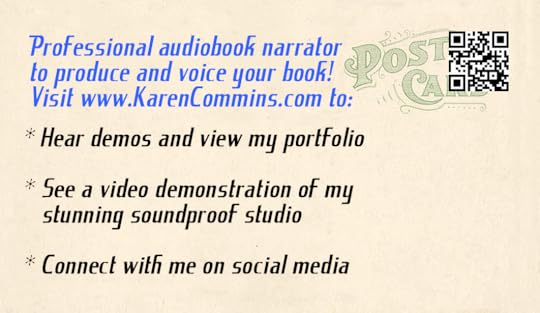
Podcasts
A podcast is defined as a digital recording of a radio broadcast or similar program, made available on the Internet for downloading to a personal audio player.
With the proliferation of smart phones, podcasts are enjoying increased visibility and popularity, and they are a perfect platform for audiobook promotion!
In a Kindle Direct Publishing newsletter, author Hal Elrod, who has sold over 100,000 copies of his self-published ebook, said, “I can confidently say that the number one key to driving book sales has been securing interviews on other people’s podcasts!”
He further commented, “A great place to start is to look on iTunes in the “New and Noteworthy” section to find podcasters who are new (so they’re not inundated with requests) but are gaining a lot of momentum and listeners. Google them, go to their websites, and reach out to tell them how you and your book would add extraordinary value for their audiences!”
You can also seek out interviews on established podcasts. Harper Audio Presents usually features author interviews, even if the author was published elsewhere. In fact, you’ll find many more terrific podcast possibilities by looking in the iTunes store under Podcasts/Art/Literature.
You even can create your own podcast and host it on your web site and/or Soundcloud. For instance, my colleague Ann Richardson and I recorded each of our InD’ear columns and uploaded the recordings to our Narrators Helping Authors Soundcloud account. If you hold a Google hangout with your narrator and/or fans, you can extract the audio and repurpose it as a podcast.
Radio Shows
A podcast interview is valuable experience and can definitely drive sales, but a real radio station has many more listeners. However, unless you’re a celebrity author, the media probably won’t come looking for you. As with podcasts, you can contact local radio stations and ask to be a guest on a show.
According to morning show host Wayne Kelly, the key to booking radio interviews is that you do NOT want to approach the producers as an author promoting a book! The producer could fear booking an introverted author who would provide no value to the listeners. Instead, you would position yourself as someone who increases audience interest with your specialized insight and comments about current stories.
First, keep a list of topics covered in your book. Authors who research topics for fictional stories would develop expertise in those areas. When it’s time to publicize the book and audiobook, look for hot topics in the news which tie into your subject matter knowledge.
Google stations in your locale. You then can find them on social media and/or call the station to ask for the email address of the person who books the most interviews.
As you can see, you can market your audiobook with your book and as a standalone product. Want even more ideas for audiobook marketing? You’ll find them on my Audiobook Marketing Cheat Sheet! If you have questions, please leave a comment on the blog or book a personal consultation on my Shop page.
Most of this article originally appeared in the February 2016 issue of InD’Tale Magazine. I’ve updated some of the info and links.
SaveSave
SaveSaveSaveSave
SaveSave
The post 6 Low-Cost Avenues For Greater Audiobook Sales appeared first on Karen Commins.
March 2, 2018
Audiobook Resources for Attendees of VOAtlanta 2018
As a user of ACX.com since it was in its pre-launch beta test and an Audible Approved Producer, I was delighted when Scott Jacobi, Marketing Director at ACX, asked me to speak on his panel today at this year’s VOAtlanta Conference.

Scott is moderating the panel titled Chapter One — Creating Your Audiobook Career. My fellow panelists are Greg Cooler, Director of Production for ListenUp Audiobooks here in Atlanta, and Andrew Gallagher, the QA Supervisor and Production Evangelist at ACX.
Since we have a wealth of topics to cover in 1 hour, I thought it would be helpful to provide attendees with this curated, short list of companion articles from ACX’s and my blogs. Obviously, you’ll find lots more useful content to aid your career on both our sites!
Choosing and Learning Your Software
ACX Studio Gear Series Part 2: DAWs
7 Places to Learn Audio Editing for Audiobooks
A Critical Ear: The ACX Reference Sample Pack
Editing and Spacing with Alex the Audio Scientist
Regarding Room Tone with Alex the Audio Scientist
File Management with Alex the Audio Scientist
Choosing Good Royalty Share Projects
Picking the Right Royalty Share Projects
Karen’s Primer on Narrating Royalty Share Audiobooks
To Voice Royalty Share Audiobooks… Or Not.That is the question
Time Management
Simple Math About Audiobook Rates
How To Act Like an Audiobook Narrator
4 Keys to Becoming a Successful ACX Audiobook Producer
3 Ways to Increase Your Computing Power
Top 10 Q&A About Audiobook Production Although I wrote this article for authors, it answers many questions for narrators.
Outsourcing From A Narrator’s Perspective
Video: Why Use Evernote for Audiobook Pronunciation Research
Video: Using the iAnnotate App in the Corrections Process
Reviews
How do you respond to criticism?
How to Submit Your Audiobooks for Review in AudioFile Magazine
How to use Karen Commins’s Audiobook Twitter Lists
Other Important Resources
AudioEloquence.com for pronunciation research
Facebook group Indie (ACX and Others) Audiobook Narrators and Producers — You must have a profile on ACX to join this group. The comprehensive group FAQ that I created and maintained will answer more questions that you realized could be possible!
Spreadsheet of Vetted Audiobook Coaches
Twitter accounts: ACX Karen Commins ListenUp Audiobooks
The post Audiobook Resources for Attendees of VOAtlanta 2018 appeared first on Karen Commins.
February 21, 2018
7 Places to Learn Audio Editing for Audiobooks
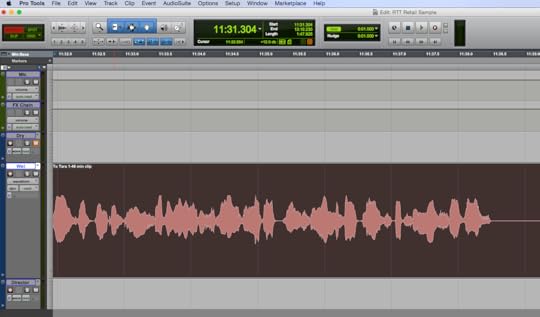
In my last article for narrators, I wrote about 3 ways to become a computer super user. One piece of software that all audiobook narrators need is a Digital Audio Workstation (DAW). Coaches and new narrators often ask me where they can learn how to use their DAW.
The 7 options listed below in no particular order will help you learn the DAW software.
1) John Florian at VoiceOverXtra has 2 webinars with George Whittam and Charles Clerke: How to Record & Edit Audiobooks Including ACX, and Audiobook Mastering Techniques. Other available webinars, including some on recording with Dan Lenard, are listed on the left side VoiceOverXtra.com home page.
2) Edge Studio offers webinars in Audition, Audacity, Pro Tools, Reaper, and Twisted Wave.
3) The Deyan Institute offers classes in Pro Tools for Production and Pro Tools for Post-Production, as well as an option for 6 hours of Pro Tools instruction.
4) Global Voice Acting Academy has several webinars on recording and occasionally offers classes.
5) Lynda.com is a FANTASTIC site with professionally produced video courses on Pro Tools, Audition, and Studio One, plus tons of other courses on things like WordPress, marketing, etc. Anyone can get a free 10-day trial using this (affiliate) link.You may be able to access Lynda for FREE with a library card as described in this article.
6) You might find a course at a local college or hire a student to teach you. For example, I took an enrichment class on Pro Tools offered on successful Saturdays at the Art Institute of Atlanta.
7) YouTube overflows with how-to videos for numerous DAWS. One excellent source for Studio One videos is the Red Baarns channel created by audio engineer Don Baarns. He also has created tutorials that show how to use iZotope RX products to clean up your audio.
By the way, if you learn the basic shortcuts keys discussed in the previous article, you have a head start as they will work in your DAW!
SaveSave
The post 7 Places to Learn Audio Editing for Audiobooks appeared first on Karen Commins.
January 17, 2018
3 Ways to Increase Your Computing Power
An interviewer once asked me what I learned while working in information technology that helped me in my profession as an audiobook narrator. A 25-year career in a variety of IT positions including programmer, network and email administrator, and technical specialist certainly gave me an ease and confidence about utilizing a wide variety of software on my computer. I want to share 3 things that will help make you a computer super user.

1. Learn as much as you can about each software package that you use, especially its shortcut keys.
This tip is not only the #1 tip on this list, but it’s my #1 tip about how to improve your work flow.
Moving your mouse to select menu options takes longer than pressing a couple of keys to accomplish the same thing. Those extra few seconds may not seem like much on a single action, but they really add up over time. I saw one study that said office workers could save 8 days in the course of the year by learning shortcuts.
Software operations are transferrable skills. If you will spend a little time to learn the shortcut keys to copy and paste in one application, you’ll use the same keystrokes in all of them. Also, if you decide to move from a PC to a Mac or vice versa, the same basic keystrokes will perform the same functions.
Below are 10 common keyboard shortcuts dealing with text that work across applications. I use them all of the time! First, you highlight the text on which to perform the operation, then press the shortcut keys.
On a PC, you press the CTRL key in combination with another; on a Mac, you press the CMD key. Since I use a Mac, I’ll list the keyboard shortcuts for it.
Copy CMD-C
Paste CMD-V
Cut CMD-X
Bold CMD-B
Italic CMD-I
Underline CMD-U
Undo CMD-Z
Add hyperlink CMD-K
Select all CMD-A (no initial highlighting needed)
Find CMD-F
In addition to common tasks, each software program has shortcut keys for functions specific to it. For instance, when I was editing my audiobooks in Pro Tools, I decided to learn a few specific shortcut combos in it. Once I incorporated these 6 time-saving alternates, I felt my productivity improved by a quantum leap rather than a baby step.
Insert Silence Shift-CMD-E
Paste Special/Repeat to Fill Selection Option-CMD-V (I use these first 2 shortcuts back-to-back to insert room tone in my recording.)
Batch Fades CMD-F (often used after pressing CMD-A to select all clips rather than simply fading between 2 clips at a time)
Consolidate Clips Option-Shift-3 (again after pressing CMD-A to select all clips)
Export Clip as File Shift-CMD-K
Memory Locations Window CMD-5 on number pad
Don’t feel like you have to learn all the shortcuts available in your software! To start, pick 3-5 of the things you frequently do in a single program. As you mouse through the menus to find your selection, notice if the option lists some keystrokes on the line. Write down those keys and use them the next time you need to do the same task.
Of course, an even speedier method of finding the shortcut keys for any program is to search for them online. Even Google’s Gmail has keyboard shortcuts.
With a little practice, the shortcut keys will be absorbed into your kinesthetic memory. You’ll do them without even thinking and get faster every day!
2. Choose your operating system and software upgrade dates very carefully.
Don’t upgrade your operating system the moment Apple or Microsoft releases a new update. Also, don’t upgrade in the middle of a book if you can avoid it. The cutting edge of technology is often the bleeding edge of technology!
New operating systems often cause existing programs to fail because other developers may not have modified their application. If you’re using Pro Tools, you’ll want to check the Pro Tools Operating System Compatibility Chart before you make any updates.
If your system is stable and satisfactorily performing all of your tasks, assess whether you truly need an update. I’m still running Mac OS 10.10.5, also known as Yosemite. Apple has released 3 new systems since the time of my last OS update.
I initially didn’t upgrade because Pro Tools, which is my most important software, wouldn’t run on the new operating system. I am also still running Pro Tools version 11.3.1, which is not the latest for that program. However, I didn’t see any features in the latest version that I had to have, so I haven’t spent the money to upgrade.
If I upgrade my OS now, I’ll also probably have to upgrade Pro Tools. According to the chart linked above, my version of Pro Tools isn’t guaranteed to run on a newer OS.
People worry that Apple or Microsoft won’t support their OS if they fail to keep up with upgrades. At some point, that statement becomes true. I’m simply saying that you need to be in control of the decision to upgrade your system, not the manufacturer. You should be okay as long as you have a safe copy on DVD or USB drive of the installation software in the event you need to re-install the OS after a system failure.
3. Keep calm, and compute on.
Errors sometimes occur on even the most stable system. When troubleshooting, always retrace your steps to the last time the system was operating correctly. What changed in the meantime?
Use your favorite search engine and enter the exact error message of any software to learn how to troubleshoot it. You most probably aren’t the first person to experience an error. In fact, your search results usually will include numerous sites. Sometimes you’ll have to extrapolate from others’ situations in order to solve your problem.
Once I find solutions to any computer problem, I save them in an Evernote notebook. That way, if the issue re-occurs, I’m not reinventing the wheel to find the answer.
We had this saying in IT: “the only day you need to do a backup is the day before your system crashes.” You never know when a system will malfunction, but Murphy’s Law increases the probability that it will happen when you can least afford the time — and possibly money — to deal with it.
In addition to doing regular backups on another drive, I highly recommend that you include some measure of off-site storage in your data safety and recovery plan. I learned the hard way that having only one copy of critical data is asking for trouble. In the early 2000s, I was editing one of my first audiobooks when the drive crashed. I had to pay to get the data recovered.
Now, at the end of each day’s recording session, I copy my book files to Dropbox. If my computer fails or, worse, something happens to my house, my audiobook files are safely stored in the cloud.
In case you don’t know, I love my computer and computing devices! By following these 3 tips, I hope you will feel more empowered when you are in front of your computer.
The post 3 Ways to Increase Your Computing Power appeared first on Karen Commins.
January 10, 2018
Audiobooks Are Not Easy Money
A journalist requested an interview with me last week to talk about audiobook narration, my favorite topic. I asked her to send me a list of questions and offered to write out some answers for her.
I knew this wouldn’t be a typical interview when I saw 2 questions:
How much money do you make?
What do you use the money for?

I realized that she wanted to interview people with side jobs rather than full-time occupations. It turns out that she was writing a column named “Easy Money” and was surveying multiple ways to make money that are associated with books. Her editor had seen listings on Upwork.com where people are looking for audiobook narrators and thought this job would be a good one to add.
I told her that I didn’t want to be included in her story because audiobook narration and production are definitely NOT ways to earn easy money!
As you learned in this article, narration is not as easy as reading aloud. Authors who are new to audiobooks are often shocked at the cost of production.
Also, due to the dramatic growth of the audiobook industry, authors perceive that sales for audio editions are easily made without much or any effort. I therefore thought it would be good to write an article this week about 3 financial aspects of audiobook production so authors can have realistic expectations.
1. It might take years to show a profit.
First of all, understand that audiobooks are a long game. One author said on-line that she had “lost money” because she hadn’t recouped her costs of audiobook production within a year. I wanted to tell her that she needed to view it with this mindset: her money was not lost, but it was used for a capital investment in her business. Capital investments often take many years to pay out.
If you need instant gratification, must recoup your investment immediately, and/or don’t have funds to meet your living expenses, you should wait to produce your audiobook.
While you can and should do things to specifically market the audio edition, you still must market the BOOK in order for it to gain visibility and sales.
When I say the book must be marketed, I mean you have to expend more energy and (probably) money than just posting about your book on social media or changing the sales price. Simply tweeting about the book or even the audio edition of it won’t do much, if anything, to move the sales needle. Repeated tweets on the same subject don’t gain much attention and become part of the noise. And changing the price makes no difference if you don’t have a way to attract people to your sales page.
For every 10 ebooks you sell, you might sell one audiobook. Royalties are paid based on the revenue received from the purchase price, not the full retail price. You might earn $2-4 for each audiobook sold, so you can see it could take a while for the audiobook to start earning a profit.
2. Royalty Share contracts aren’t for everybody.
In breaking down the expenses for audiobook production, the narrator’s fee is usually the largest cost. To get around this obstacle, ACX.com allows audio rights holders to set up royalty share (RS) contracts with the narrator. The narrator isn’t paid anything up front. Her fee is deferred to her half of the royalties paid each month.
To an author, royalty share contracts look like free narration and an easy (there’s that word again) way to produce an audiobook.
To a narrator, though, a royalty share contract looks like the author doesn’t have confidence that her audiobook will sell enough copies to earn back the costs of production. The author makes money from all of the editions. The narrator only makes money from the audiobook and therefore is shouldering all of the risk for low or no sales on an RS contract.
One author was quite miffed with me when I said I could not accept her offer of royalty share plus $30 per finished hour because I would still be in the red for my editor’s fee and didn’t think I’d earn back my narration fee.
Before answering her, I had analyzed her Amazon sales rank and reviews for ALL of her books — not just the one she wanted to produce in audio. I told her that I wasn’t convinced she had sufficient selling power for me to take the risk of earning back my narration fee and the full cost of my editing. I told her I could do the book for my per finished hour rate or on a royalty share contract with a much higher author stipend.
She told me my rate was was misleading and that I had wasted her time. My ACX profile states I’m available for “royalty share or unspecified”, so I am not misleading anyone.
I can’t take every royalty share book I’m offered because it’s a serious commitment of my time and money to produce an audiobook. I must have some evidence that I can recoup my costs from the royalties. Otherwise, I couldn’t make enough money to sustain my business and/or might miss the opportunity to take work that pays up front.
Generally, a narrator would be able to earn her fee and expenses over time on an RS contract if one or more of these factors is true (the more, the better):
You routinely sell 500 copies a month of the ebook.
Your Amazon sales rank is less than 100,000 and preferably 50,000 or less. If it’s over 1 million, a narrator knows that the other editions aren’t selling frequently, so the audiobook couldn’t be expected to sell, either. Be sure to point us to your best-selling edition as I described in this article .
Your book has an average rating of at least 4.0 with at least 50 recent 5-star ratings from genuine reviewers.
The estimated finished time of your audiobook would be 6-9 hours, which means your manuscript has around 55,800 to 83,700 words. If the audiobook is shorter than 6 hours, Audible listeners might be reluctant to use a credit to buy it. Purchases made with Audible credits tend to reap the largest royalties. If it’s longer than 9 hours, even more copies must be sold before a narrator earns out her fee and expenses.
In other words, a narrator is most interested in a royalty share contract for those books that are selling or can be expected to sell consistently in other editions. However, in those cases, an author is best served by paying the narrator her rate (usually $200-400 per finished hour) and retaining all royalties. This article further discusses your options and the break-even point.
3. Money makes the world go round.
I read a comment in an on-line forum that stated many indie authors are struggling to meet their living expenses. The person continued by saying that an extra $4 means the world for some people. I gathered that struggling authors create royalty share contracts with the thought that whatever revenue they might get from an audiobook would be better than nothing.
While I can understand and even relate to the “hard times” mentality, I strongly advise against creating audiobooks only for the money. Loyal listeners appreciate audiobook narration as an art form. New listeners might never listen to another book if their first experience is negative. In both situations, a sub-standard product created for the money will negatively affect the industry as a whole.
After getting a divorce from my first husband, I worked 2 jobs in order to pay my expenses and start saving for the life I wanted. When I decided to take a voiceover workshop and produce a demo, I didn’t expect the teacher to invest his time in me because he thought I had potential. Instead, I sold all kinds of stuff on eBay in order to pay him for teaching me and producing my demo. I did the same thing when I wanted to buy a harp.
Rather than producing an audiobook prematurely and only for the money, consider doing the exercise described here to figure out other ways of acquiring money.
By looking at the big picture, paying for production, and earning sustenance funds through other means, authors can find that their audiobooks are a steady revenue stream. Over time, the capital investment will turn into pure profit. In the meantime, audiobooks bring an author’s work to new audiences and are more discoverable by new fans.
Is this the year you’re planning to create an audiobook? What questions do you have about the process? Please leave me a comment and let me know!
The post Audiobooks Are Not Easy Money appeared first on Karen Commins.
January 3, 2018
Resolutions and Intentions
What lies behind us and what lies ahead of us
are tiny matters compared to what lies within us.
— Henry Stanley Hoskins (not Emerson as I originally believed)
It’s day 3 in a new year. Have you already broken your New Year’s Resolutions?
At the end of 2016, I took Michael Hyatt’s 5 Days to Your Best Year Ever course. (This book is based on that course.) On day 3 of the course, he wrote about New Year’s Resolutions:
The average person makes the same New Year’s resolutions ten separate times without success.
After going through all of the exercises in Hyatt’s course, I confidently started 2017 with several specific goals in the areas of health, career, and avocation. I was making progress on all of them until mid-May.
Drew’s parents, who were 93 and 92 at the time, had been in good health for their age. They both were able to walk and care for themselves, and they were still living independently in their house of 54 years. He still drove, they did their own shopping, and they did all of the personal care activities that we take for granted. We enjoyed lunch with them at a restaurant on 12 May. In a blink of an eye, life changed.
 Drew and his parents in June 2017. They were at rehab, and we were hoping for better days to come.
Drew and his parents in June 2017. They were at rehab, and we were hoping for better days to come.On 14 May, Drew’s father had emergency stomach surgery. He was still in the hospital and not doing well on 21 May when Drew’s mother had a major stroke and became another hospital patient. Her stroke zapped the communications area in her brain and the right side of her body, leaving her unable to express or care for herself.
Suddenly, chaos had tossed aside all of my goals along with our orderly lives.
Drew is an only child, so looking after his parents’ health care and finances immediately became our responsibility and almost a full-time job. They were in the hospital for about 3 weeks and discharged to a rehab facility for over 2 months. While at rehab, Mom broke her hip and was hospitalized again.
We researched and toured assisted living facilities and moved them into one in late August. We also had to clear out their house, which was an overwhelming undertaking. Since they were children in the Great Depression, they never threw away anything. For instance, Mom still had the greeting cards people sent her when she graduated from nursing school 70 years ago! Emptying their house was a time-consuming ordeal that required weeks of our manual labor spread out over several months.
Meanwhile, in September, Dad went back in the hospital for over a week. Sadly, he passed away in October.
Mom is devastated. In the 64 years Drew’s parents had been married, they rarely were away from each other.
We continue to spend time with her multiple times each week. She seems to be deteriorating every day. Even when we aren’t with her, we are thinking about her, talking to her caregivers, dealing with her finances and Dad’s estate, trying to sell the house, etc. The situation with both parents is never far from the surface and can be a large distraction on a daily basis. Drew and I often need to tell each other to come back to the present moment.
I don’t relate this story of our 2017 challenges to gain your sympathy, but rather to talk about setting intentions for the new year. Hyatt teaches that you should acknowledge the past before planning for the future. In the session for day 2, he asks:
What if our greatest frustrations from the previous year were actually pointing us to some of our biggest wins in the next? What if disappointment was just a road sign pointing to personal transformation?
Through all of the trials this past year, I learned or re-learned several things.
First, when my time is spent in service of other people, I don’t have time to think about jobs I’m not getting or goals I’m not achieving. One day, I admit that I felt a bit resentful that I once again had to stop what I was doing toward my business so we could visit Mom. When I was sitting in front of her, though, I was completely at peace. I knew that I was right where I was supposed to be. Drew has always been my number 1 priority, with family in second place. I have plenty of time to achieve my goals and won’t have regrets later in life.
No matter how bad you think you’ve got it, somebody always has it worse. The hurricanes and wildfires that suddenly displaced and killed people are far more traumatic events than my in-laws’ medical problems.
Finally, the situation reminded me to be kind to everyone I meet. Most people are going through something, but we may not know it.
This year, I’m not making resolutions, and I’m not going through Hyatt’s process of goal-setting. Instead, I’m declaring 4 new, simple intentions:
Remain present in the moment.
Find something each day to be grateful about.
Realize that I am not in charge of when and how my goals will be attained.
If a negative train of thought pulls into my station, I’ll rebook my ticket for the train on the positive track.
How are you planning to approach 2018? Please leave a comment and let me know!
The post Resolutions and Intentions appeared first on Karen Commins.
December 27, 2017
Should An Author Narrate Her Audiobook?
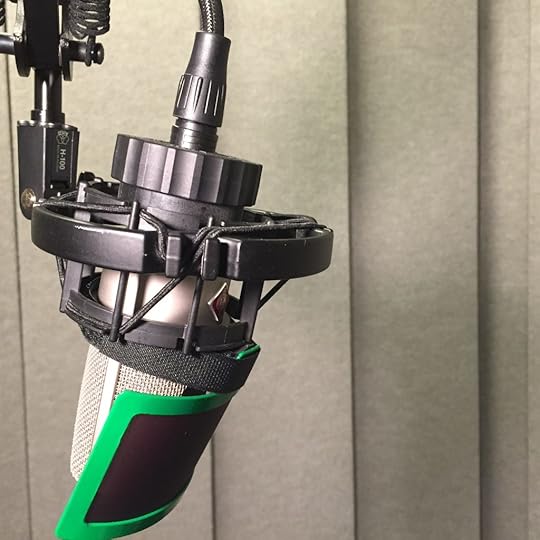
One question that I’ve seen and heard repeatedly from authors and listeners is: How is a narrator selected to read the audiobook?
In addition, many authors tell me that they want to narrate their audiobooks for financial and/or artistic reasons.
At first glance, the author might seem to be the most logical choice for the narrator. The author has labored over every word in the book and obviously is the person most familiar with its arc and important points.
However, many avid listeners refuse to listen to books narrated by the author because they have frequently discovered that the writer is not necessarily the best performer.
I always advise authors and publishers to select the narrator who can best serve the text. The following 3 questions guide the casting process:
1) Is the book fiction or non-fiction?
2) What narrative point of view (POV) is used in the book?
3) Who is paying for the production costs?
Fiction Or Non-Fiction
Professional narrators almost always perform fiction books because they have the acting training and experience necessary to convey the wide range of characters, accents, and emotions in the story. I know of only a few instances where devoted listeners raved over an author’s rendition of a fiction audiobook. These books were set in the same geographic location as the author, and the characters shared her accent.
Author performances of their non-fiction works, especially memoirs or comedic essays, are much more common. Listeners often comment that they enjoy hearing the voice of the author as she tells her own story.
Regardless of genre, listeners still expect an engaging experience. Listeners commonly complain that authors have not had vocal training and therefore are more likely to offer a dry read, speak in a monotone voice, and breathe at points that make the writing sound choppy.
An experienced narrator reads and absorbs the entire book and perhaps does additional research to understand the setting, as well as perfects dialects and determines correct pronunciations.
Point Of View
Beyond genre, the narrative POV affects the choice of narrator.
Either gender can perform texts written in third person. The narrator’s gender typically would match the gender of the main characters.
For instance, if a man wrote a book in third person that has a majority of female characters, he shouldn’t narrate the audiobook. A female narrator is the natural choice. If the number of characters for both genders is about equal, the narrator might be the same sex as the author.
In narratives with first person POVs, the narrator should always be the same gender as the main character in fiction or the author in non-fiction. The opposite gender will not sound right to the listener and will drop them out of the book. You can only suspend belief so far!
For example, two narrators recently related a similar situation. They each had a friend who wrote a book, and the friend wanted the narrator to voice it. In both cases, the friend wrote a personal, non-fiction account and was the other gender from the narrator in question.
Of course, the narrators wanted to honor the friendship and hoped to do the work, but they were a terrible casting choice for the material. In fact, one of them was a man who was asking about narrating his female friend’s memoir detailing her survival of domestic abuse. I cannot even imagine a scenario when choosing a male voice to speak in first person about this sensitive issue would be a wise decision!
A popular trend these days with romance books is to split the text with alternating chapters in first person POVs for both the hero and the heroine. These books require a dual male/female narration in the audiobook. Otherwise, the listener would fall out of the story and might return the audiobook because a single narrator could not sound credible for all of the text.
Another narrating trend gaining in popularity with first person POVs is a duet narration, where each narrator performs all of their gender’s dialogue throughout the book. This narration style carries the highest price tag as both actors ideally need to record together at the same time, either in person or via video chat. If they aren’t in the same studio, matching the sound quality can be a big challenge. Recording separately can lead to disjointed dialogue because the actors wouldn’t have the benefit of hearing each other. As I explained in this article, editing the dialogue is an extremely detailed, labor-intensive process, further adding to the production expenses.
Production Costs
The answer to question 3 about the costs of production may mandate that a professional narrator be employed.
When an author publishes with a traditional publisher, that publisher may produce an audiobook or license the audio rights to another publisher without the author’s input. These print and audio publishers schedule the audiobook production and pay all of the costs: recording studio, engineer, director, producer, and narrator. The author usually is not offered the option of narrating his title. Instead, the producer would go through her known pool of talent to solicit narrator auditions and make casting decisions.
An audiobook performance is very different from a staged, short reading at a bookstore. Just as it takes time, focus, coaching, and practice to become a skilled writer, the same is true of becoming a proficient and efficient audiobook narrator. For this reason, even indie authors who were considering narrating their books may find it cheaper and easier to hire a narrator than to attempt to become one.
Although it seems like we’re simply reading aloud, narrating an audiobook is an extremely challenging and demanding performance medium! Most people hate the sound of their own voice because they aren’t used to hearing it. Here are 9 other things professional narrators do that authors usually struggle with:
Understand the subtext and add the appropriate emotion, inflection, and tone for each word without speaking in aural pattern like a newscaster or a children’s sing-songy rhyme.
Be like Goldilocks when setting a reading pace. The tempo can’t be too fast or too slow; it needs to be right for the material.
Read all of the words on the page in the order they are written, without adding, subtracting, or transposing any of them and still tell the story in a convincing way while maintaining the right accent, character voice, and/or tone. Whew! Even writing that list was tiring!
Develop believable character voices and maintain consistency of those voices through multiple recording sessions spread across a number of days. All voices and tone should sound the same throughout the entire book so that it sounds like it was recorded in a single session.
Record in an ultra quiet environment free from extraneous noises like children, pets, appliances, aircraft, and lawn tools. The microphone hears all of those sounds. If they make it into the final recording, listeners are annoyed by the poor production quality. You even need to wear quiet clothes!
Minimize lip smacks, tongue and teeth clicks, breathing noises, and stomach rumbles while still sounding natural.
Re-record any sentences that have mistakes. If I make a mistake in words, inflection, or character’s voice, we stop the recording, and I say the sentence again. If I decide I want to play a different emotion, we stop the recording, and I say the sentence again. This process occurs constantly during the original recording sessions.
Finish the recording sessions in the time allotted, which can be an aggressive schedule. The industry rule of thumb is that it takes 6 hours in real time to produce 1 finished hour of audio . A 10-hour audiobook therefore may require 60 or more hours to record, edit, proof, correct, and master the audio files.
Ensure that any corrected recordings will have the same sound, character voice, and energy as the original recording. I play back my original recording so that I can reproduce it when recording the correction . The new audio is seamlessly inserted into the original. The whole book should sound as though I read it in one sitting.
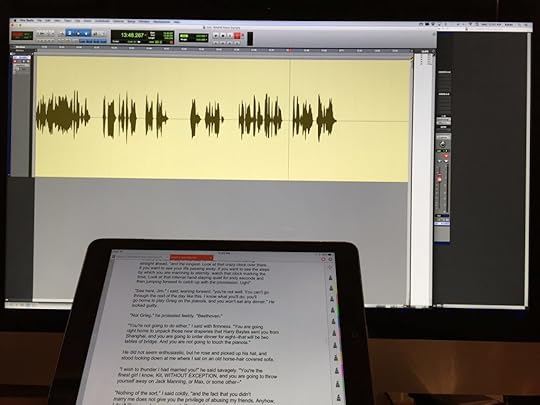
While some narrators pay hourly rates for studio rental and an engineer, many professional narrators create audiobooks in our own studios. Doing so means that we overcame a minimum of 4 additional technical challenges that give authors fits:
Established a dead quiet space for recording. I live in such a noisy area that I took the extreme and expensive step of building a soundproof room onto my house!
Purchased and learned how to use an appropriate microphone, hardware interface to the computer, and computer. A telephone headset microphone is suitable for telephone audio, not an audiobook.
Selected recording software and survived the steep learning curve in understanding how to use it to record and save audio files.
Studied the techniques of editing and mastering the recordings to eliminate mistakes and make the audio sound pleasing to the ear, or hired a freelance editor to perform these tasks.
Aside from these 13 apects of narration, a big reason that most authors don’t narrate their audiobooks is so that they can stay immersed in their writing and create more books!
This article originally appeared in the April 2016 issue of InD’tale Magazine. I’ve updated it and added more links.
SaveSave
SaveSaveSaveSave
SaveSave
SaveSave
SaveSave
SaveSaveSaveSave
SaveSave
SaveSave
SaveSaveSaveSaveSaveSave
SaveSave
SaveSave
The post Should An Author Narrate Her Audiobook? appeared first on Karen Commins.
December 20, 2017
Antidote For A Dry Spell

As I wrote over 10 years ago, in order for your ship containing job contracts to come sailing in to your harbor, you have to keep sending out promotional and prospecting ships into the world. But what happens when you don’t see any results from your efforts? It’s so easy to fall into a negative mindset, especially when it seems that every narrator you know is announcing on social media that they had scheduled work through the next 6 months even before they were just hired for a 10-book series.
I still am not at the level of success that I envision, and some days, the critical voice in my mind starts in on me about what I haven’t accomplished. I notice that mean girl never gives me credit for all of the things I HAVE done! No matter how circumstances may appear in the moment, the key is to push the doubts away and keep marching toward your dream.
In 2012, Dave Courvoisier wrote candidly on his blog about a dry spell he was experiencing in gaining work. In this article, I’m including and expanding on my response to him.
First, it’s possible to want something so badly that your desperation to have it can actually push it away from you. I wrote about this phenomenon in the article Voiceover and the Law of Paradoxical Intent.
I can tell you honestly that it was only after I truly ACCEPTED my life as it was that things really started to move forward for me.
Second, the number of jobs booked in a time period is only one small way of measuring success. I wrote about 3 techniques for maintaining a feel-good mentality about your career in the post The feel-good voiceover blog post of the summer!. I write my articles for myself as much as for my audience, and this is one post that I often re-read to maintain balance and objectivity during slow times.
I cannot overemphasize the 3rd technique too much — STOP THE COMPARISONS TO OTHER PEOPLE! It is the single greatest act of self-negation that keeps us from our good.
In fact, when I listened to Rob Lowe’s most excellent narration of his autobiographical audiobook Stories I Only Tell My Friends, I heard a compelling reason to keep going forward with your dream. When Lowe talked about meeting an unknown LeVar Burton about a week before ROOTS was aired on TV, he said:
“It showed me how quickly the rocket fuel of stardom can ignite, how unimaginably GIANT the g-forces can be as you are propelled into fame’s orbit.
Looking back, I also wonder at the mystery of destiny and fate. I marvel at the mercurial forces of fortune and am reminded that one must be ever vigilant to stay on one’s own path, without envy of others.”
When I don’t know what the next step is, I just take one. It doesn’t matter what it is. It doesn’t matter if it’s the best thing I could do at the time. It doesn’t matter if other people agree with me, cheer me on, throw spitballs my way, or totally ignore me.
It’s not about them. It’s about me. It’s about “staying vigilant on my path, without envy of others.”
All that matters is that I take that step…..because that step gets me one step closer to the life I’m meant to lead.
Law of Attraction
Shortly after I responded on Dave’s blog, I wrote the article Power of “I Am” In Maintaining a Positive Attitude. Whatever you put after those 2 words becomes a self-fulfilling prophecy.
A passage in the 12/15/17 Science of Mind magazine daily guide really brings home this point.
“Whenever a negative, demeaning thought is believed and allowed to repeat, it is a prayer. “I am [blank] is a prayer. This thought repeatedly spoken becomes a belief. A belief becomes a reality, a prayer answered. By repeating the thoughts, “I am not good enough”…or “Life has always been a struggle”, I am actually creating that reality.
One of our greatest tools is practicing discipline with what we allow ourselves to think. The reality is that you must first believe your affirmation to be true of you.
…See and know your good, then praise and embrace it.”
We need to keep thinking and believing that the success we seek is coming to us. What we think about expands. If we focus on what we think we lack, we will continue to experience more of the same lack.
Just because things don’t happen on our timetable or in the way that we would expect them to show up doesn’t mean they aren’t going to happen. They probably will happen and be even greater than we could imagine!
Just keep smiling, taking steps, and sending out those ships!
The post Antidote For A Dry Spell appeared first on Karen Commins.
December 13, 2017
Is This Coach Right For Me?

When people ask my advice about getting training, I refer them to my article 10 questions to ask coaches and demo producers and this spreadsheet of vetted audiobook coaches. Recently, someone told me she wanted to develop confidence and wondered whether I thought a particular coach was sincere. I recognized that she really wanted to know if the coach was right for her before she committed to spend the money for the course.
I decided other people may find my answer with 4 additional questions to be useful, so I’m posting the modified version of my reply here.
I understand and can appreciate the conflict you feel. Since you don’t know me, I doubt my opinion about a coach’s skills or sincerity would bring you to a decision.
Instead, let me ask you 4 questions that may help you clarify and narrow your thoughts so you can come to a resolution. You don’t need to answer me; these are just points for you to ponder.
What exactly do you think you need help with?
Does the coach offer a free consultation?
Have you tried the techniques in the book GET CLIENTS NOW! ?
The most important question — If you spent the money for the personal sessions or course, what outcome would you expect to do, be, or have?
“Confidence” is too broad a subject; it’s an umbrella over many topics. You need to break it down into something specific.
Are you getting stuck at a particular point in the marketing process, like prospecting or closing sales? Do you get nervous speaking to others? Or, are you looking to launch a new business and don’t feel prepared for it? Once you identify exactly what you want to learn, you’re in a much better position to decide the best service provider for that kind of training.
I think when something is meant for us, we feel excited on the inside. We feel energized. We think, “Oh I must do THAT!”. When it’s right for us, we don’t have to analyze a decision from every angle and try to talk ourselves into spending the money.
One final thought – – sometimes I have bought courses and then not done my part to go through the materials and do the homework involved to actually master the topic. It’s like I somehow think I will learn it through osmosis.
I realized that I considered it taking action to buy the course, which made me feel better temporarily.
However, I’ve discovered that forward motion only occurs when I do all the work and then actually implement what I learned in my business.
We can’t expect assurances that our dollars always will be well-spent. I can say with certainty, though, that if you’re taking a step in your career that seems to be in the right direction, you are not making a mistake, even if your expectations aren’t met.
SaveSave
SaveSaveSaveSave
SaveSaveSaveSave
SaveSave
SaveSave
SaveSave
SaveSaveSaveSave
SaveSave
The post Is This Coach Right For Me? appeared first on Karen Commins.
From Casting a Narrator to Happily Ever After
Last week, I looked at the Audiobook Creation Exchange (ACX.com) as a matchmaking site between indie authors and narrators. Today in part 2 of the series, we’ll continue exploring the ACX process, from casting the narrator you love to living happily ever after with your completed audiobook.
I should mention at this point that ACX refers to everyone on the production side as a producer. Some producers only manage the project, but most ACX producers are also the narrator with whom you will contract your book. Therefore, I’ll use these 2 words interchangeably.
In most cases, one narrator will perform the entire book, giving voices to characters of both genders. You can find your ideal narrator by taking either of 2 non-mutually exclusive paths on ACX: contact narrators individually, or let them find your title.
Receive Auditions
You can use ACX’s Search function to look for producers meeting certain criteria: genre, gender, language, accent, voice age, voice style, payments, location, and Audible Approved. Many of these selections look familiar because you chose them when you created your title profile. You can also search for narrators who have posted samples that meet your specifications.
One important selection criterion is Audible Approved. According to ACX, these producers are:
…the crème de la crème of ACX…extra-dependable, knowledgeable members [who] have a verifiable record of achievement in the audiobook industry […with] favorable reviews of [their] productions…our seal of approval; the thumbs-up from Audible.com…[the producer is] experienced and trusted.
If you hear a narrator you think is a good fit for your story, you can send that person a message through the ACX internal communications system to invite her to audition.
Searching through the thousands of producer profiles and samples can seem overwhelming and time-consuming. Many people prefer to simply let narrators find the title and submit auditions.
Regardless of which path you chose for gathering auditions, your casting workflow will be the same.
Evaluate Submissions

Before I met my husband Drew, who is the hero of my life story, a friend gave me a short booklet titled HOW TO GET MARRIED. She meant it to be a joke, but it actually had some good advice. The only thing I can remember from it is that I filled out a checklist of traits that I wanted in a husband. When I met Drew, I remember mentally putting checkmarks by everything on my list!
I’m reminded of my fairy-tale beginnings with Drew because I have the same advice for you: create a checklist of the qualities you want in your narration to help you evaluate each audition.
Like falling in love with the wrong man, falling in love with a particular narrator’s voice without regard to other factors can lead to disastrous consequences! You want to hear a narrator with acting ability who is fully engaged with your text. She adds nuance to the narrative sections as well as the dialogue, and she may even surprise you with her interpretation of your words.
In short, your goal when listening to auditions is to cast the narrator who is in the best service of the text and fulfills your vision in telling your story.
Here are 10 questions for your listening checklist:
Does the narrator sound like the voice you heard in your head? Realize, though, that a particular pitch or tone is only a single characteristic and shouldn’t be the overriding factor in your casting decision.
Does the narrator sound like a synthesized voice reading text to speech? Does she deliver the words in a sing-songy manner or with a set pattern to her rhythm? If you answer “yes” to either question, keep looking!
If your subtext contains humor, how well did the narrator use timing and inflection to indicate she got the joke and is making sure the listener understands it?
Can you distinguish between characters without looking at the text or hearing the dialogue tags?
Did the narrator pronounce all of the words correctly?
Do you hear any sounds in the background, like the computer fan, chirping birds, kids, TV, the refrigerator, paper or clothes rustling, a lawnmower, etc.? Did you hear variations in volume or sloppy edits? Carefully listen to auditions through earbuds or, even better, headphones to evaluate the recording production quality.
Does the narrator speak too quickly, too slowly, or at a comfortable speed? Can you understand everything she says without backing up and re-listening to passages?
Is her diction either slurred or so precise that you start focusing on how she’s saying the words rather than the meaning she intends to convey?
How well does the narrator fit the character mindset and book style?
Does the narrator have experience and good reviews in your genre? If her audition sounds good to you, look at her ACX profile and check out her portfolio of audiobooks on Audible.com.
As you hear each audition, you can click on the screen to Like or Dislike the audition in order to develop your short list of favorites. Don’t worry about hurting the producer’s feelings if her audition is not a good fit for your book! Narrators do not receive any notifications indicating you’ve listened to an audition.
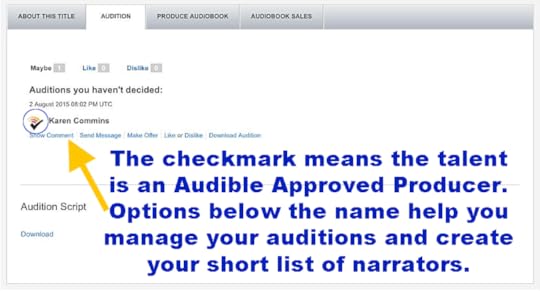
Make An Offer
Remember your first date? It’s easy to get dazzled by the first person you go out with and think that they are the ONE!
Listening to your book voiced by a professional actor for the first time can cause the same sort of heady rush. Your perfect narrator may have submitted the first audition you heard, but generally, you’ll need to listen to more than one audition to know whether a narrator is truly a good fit for your book.
You could receive so many great auditions that your casting decision becomes more difficult, but that’s a good problem to have!
Before you extend an offer, here are 4 points to remember:
Some authors want to post their short list of auditions on their web sites to get votes and increase buzz among family, friends, and fans. The narrator owns the copyright to her performance in her submission, so you will need her advance permission to publicly post her file.
Note that if your book is in a series where the main characters appear in each book, be aware that listeners like to keep the same narrator throughout the series. I’ve seen some authors who were eager to get their books into audio and simultaneously offered contracts to different narrators to voice the same characters in a series.
ACX does not allow you to negotiate on or make any changes to an offer. You really should send a message to the producer BEFORE you send an offer to determine her availability and negotiate the deadlines for your work.
It’s not uncommon for an author to request a second, short audition of a different selection from the talent on her short list.
You can click on the Make Offer button from the producer’s audition in your Dashboard that you thought was the best match for your story.
You also can send an offer directly to a narrator without even hearing an audition by going to his narrator page and clicking Make Offer. A drop-down will come up with your available titles; books with outstanding offers won’t show up in this list. You click on the title that you want to offer him and follow the directions from there.
Set Deadlines
You’ll find ACX’s Production FAQ and the ACX Production Standard Terms to be extremely helpful resources at this stage. The Terms page spells out specific timeframes for any revision requests and your approvals.
In your offer, you’ll specify 2 deadlines: dates for the first 15 minutes, and the completed audiobook.
Once a narrator accepts your offer, you must supply the final, recordable manuscript within 3 business days. Let your narrator know of any pronunciation issues or requests at this time.
The deadline for the first 15 minutes is in place to be sure you and the narrator are on the same artistic page. You can request adjustments in tone or acting choices such as a character’s voice before approving this first submission.
ACX has no involvement with deadlines except in increasingly rare cases where it is paying a PFH stipend. The rights holder of a stipend book must approve the completed audiobook within 60 calendar days of the date the contract was signed. Otherwise, it’s up to you and the narrator to work out any changes in the production schedule.
Within 10 business days of the audiobook’s completion, you must review the final product or request an extension from the producer for this review. Many authors attempt to give acting directions and line reads to the narrator upon audiobook completion. However, the only acceptable revision requests involve technical errors, such as noises, misreads, etc.
Once the narrator makes any corrections and you approve the recording, your new audiobook generally will be available for sale within 2-3 weeks. Congratulations, and best wishes for many more!
I’ll look at other production options in upcoming articles. In the meantime, please leave questions and comments here on the blog.
The original version of this article appeared in the November 2015 issue of InD’tale Magazine. I’ve updated it and added more links.
SaveSave
SaveSave
SaveSaveSaveSaveSaveSave
SaveSave
SaveSave
The post From Casting a Narrator to Happily Ever After appeared first on Karen Commins.



